|
|
|
Sort Order |
|
|
|
Items / Page
|
|
|
|
|
|
|
| Srl | Item |
| 1 |
ID:
084994
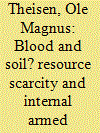

|
|
|
|
|
| Publication |
2008.
|
| Summary/Abstract |
Scarcity of renewable resources is frequently argued to be a main driver of violent conflict. The 2004 and 2007 Nobel Peace Prize awards, as well as the international debate about the implications of climate change, show the salience of the topic as a security issue. Studies testing the link between renewable resource scarcity and armed conflict have reached diverging conclusions. One study, in particular, has found substantial support for eco-scarcity theory, while most others have found a limited association. This article starts with an attempt at replicating earlier findings on the link between population density, soil degradation, deforestation, water scarcity and civil war, but several results are not replicable. The final results lend little support to a purported link between resource scarcity and civil conflict, whereas it replicates earlier findings on the importance of poverty, instability and dependence of fuel exports. A high level of land degradation is the only factor that significantly increases the risk of civil conflict, although this result should be interpreted with caution. The general conclusion of this study is that scarcity of natural resources has limited explanatory power in terms of civil violence, whereas poverty and dysfunctional institutions are robustly related to conflict. Future studies on the link between resource scarcity and violent conflict should focus on local and less intense conflicts, pay more attention to a context of low economic development, look more thoroughly into the role of state actors in the escalatory phase of conflict and assess the importance of the distribution of resources relative to scarcity per se
|
|
|
|
|
|
|
|
|
|
|
|
|
|
|
|
| 2 |
ID:
109805
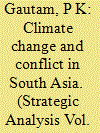

|
|
|
|
|
| Publication |
2012.
|
| Summary/Abstract |
It is now commonly accepted that small island countries are facing an existential threat because of global warming and the consequent rise in the level of the oceans.
|
|
|
|
|
|
|
|
|
|
|
|
|
|
|
|
| 3 |
ID:
110806
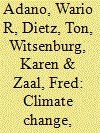

|
|
|
|
|
| Publication |
2012.
|
| Summary/Abstract |
Many regions that are endowed with scarce natural resources such as arable land and water, and which are remote from a central government, suffer from violence and ethnic strife. A number of studies have looked at the convergence of economic, political and ecological marginality in several African countries. However, there is limited empirical study on the role of violence in pastoral livelihoods across ecological and geographical locations. Yet, case studies focusing on livelihood and poverty issues could inform us about violent behaviour as collective action or as individual decisions, and to what extent such decisions are informed or explained by specific climatic conditions. Several case studies point out that violence is indeed an enacted behaviour, rooted in culture and an accepted form of interaction. This article critically discusses the relevance of geographical and climatic parameters in explaining the connection between poverty and violent conflicts in Kenya's pastoral areas. These issues are considered vis-à-vis the role institutional arrangements play in preventing violent conflict over natural resources from occurring or getting out of hand. The article uses long-term historical data, archival information and a number of fieldwork sources. The results indicate that the context of violence does not deny its agency in explanation of conflicts, but the institutional set-up may ultimately explain the occurrence of the resource curse.
|
|
|
|
|
|
|
|
|
|
|
|
|
|
|
|
| 4 |
ID:
110807
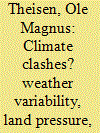

|
|
|
|
|
| Publication |
2012.
|
| Summary/Abstract |
The evidence of coming climate change has generated catastrophe-like statements of a future where a warmer, wetter, and wilder climate leads to a surge in migrant streams and gives rise to new wars. Although highly popular in policy circles, few of these claims are based on systematic evidence. Using a most-likely case design on Kenya 1989-2004, with new geographically disaggregated data on armed conflicts below the common civil conflict level, this study finds that climatic factors do influence the risk of conflicts and violent events. The effect is opposite to what should be expected from much of the international relations literature; rather, it supports the observations made by recent anthropological studies. Years with below average rainfall tend to have a peaceful effect on the following year and less robustly so for the current year as well. Little support is found for the notion that scarcity of farmland fuels violence in itself or in election years. More densely populated areas - not areas with a low land per capita ratio - run a higher risk of conflict. Election years systematically see more violence, however. The findings therefore support the notion that large-scale intergroup violence is driven by calculation and political gain rather than desperate scrambles for scarce land, pasture, and water resources.
|
|
|
|
|
|
|
|
|
|
|
|
|
|
|
|
| 5 |
ID:
139406
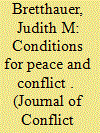

|
|
|
|
|
| Summary/Abstract |
This study applies fuzzy-set Qualitative Comparative Analysis (fsQCA) to the debate on links between resource scarcity and armed conflict. Previous studies on this relationship have reached contradictory results. This study aims to solve this contradiction by arguing that social, economic, and political conditions play an important role in determining whether armed conflict erupts over resource scarcity. I test three theoretic hypotheses, focusing on weak states, economic situations of households, and human ingenuity. I compare fifteen resource scarce cases with conflict to sixteen cases without armed conflict. My analysis supports the hypothesis that the economic situation of households and the levels of human ingenuity matter. In particular, the impact of high dependence on agriculture and low levels of tertiary education on the link between resource scarcity and conflict is discussed. While employing an fsQCA proves a valuable step in accounting for contradictory results, limits of the methods are apparent as well.
|
|
|
|
|
|
|
|
|
|
|
|
|
|
|
|
| 6 |
ID:
128869
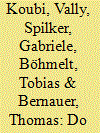

|
|
|
|
|
| Publication |
2014.
|
| Summary/Abstract |
This article reviews the existing theoretical arguments and empirical findings linking renewable and non-renewable natural resources to the onset, intensity, and duration of intrastate as well as interstate armed conflict. Renewable resources are supposedly connected to conflict via scarcity, while non-renewable resources are hypothesized to lead to conflict via resource abundance. Based upon our analysis of these two streams in the literature, it turns out that the empirical support for the resource scarcity argument is rather weak. However, the authors obtain some evidence that resource abundance is likely to be associated with conflict. The article concludes that further research should generate improved data on low-intensity forms of conflict as well as resource scarcity and abundance at subnational and international levels, and use more homogenous empirical designs to analyze these data. Such analyses should pay particular attention to interactive effects and endogeneity issues in the resource-conflict relationship.
|
|
|
|
|
|
|
|
|
|
|
|
|
|
|
|
| 7 |
ID:
110723


|
|
|
|
|
| Publication |
2011.
|
| Summary/Abstract |
This paper questions the assumption, commonly used in theoretical and policy research, that scarcity rents make up a large proportion of market prices for oil and coal. We show that the empirical literature, simple calculations of historical and future scarcity rent shares, and possible theoretical explanations all imply the same overall conclusions: that scarcity rents seem to have been marginal or non-existent historically; that they almost certainly do not dominate fossil resource prices today; and that there will be other factors shaping the prices in the upcoming decades. We therefore argue that using the scarcity rent as the main or only basis for policy or for explaining empirical outcomes is ill-advised.
|
|
|
|
|
|
|
|
|
|
|
|
|
|
|
|
| 8 |
ID:
179558


|
|
|
|
|
| Summary/Abstract |
North Korea today is a most unusual post-socialist state. Market actors and market prices are integral to economic life, but private property remains illegal, and private enterprise outside the household is de jure non-existent. In such an institutional context, some market processes are more autonomous in relation to the state, while others are more embedded within state structures. In this article, we offer a theoretical account of the shape that North Korea's market economy has taken, developed from a set of fishing industry case studies. We note four broad categories of enterprises: closely embedded, loosely embedded, semi-autonomous, and autonomous. By relative autonomy/embeddedness we mean control over fixed assets, cash flow, and operational decisions such as wage and price setting. We postulate three major determinants of embeddedness/autonomy: (1) relative strategic resource scarcity between state and market actors, (2) monitoring costs, and (3) institutional evolution that reflects these realities, though to varying extents.
|
|
|
|
|
|
|
|
|
|
|
|
|
|
|
|
| 9 |
ID:
112291
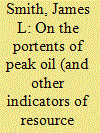

|
|
|
|
|
| Publication |
2012.
|
| Summary/Abstract |
Economists have studied various indicators of resource scarcity but largely ignored the phenomenon of "peaking" due to its connection to non-economic (physical) theories of resource exhaustion. I consider peaking from the economic point of view, where economic forces determine the shape of the equilibrium extraction path. Within that framework, I ask whether the timing of peak production reveals anything useful about scarcity. I find peaking to be an ambiguous indicator. If someone announced the peak would arrive earlier than expected, and you believed them, you would not know whether the news was good or bad. However, I also show that the traditional economic indicators of resource scarcity (price, cost, and rent) fare no better, and argue that previous studies have misconstrued the connection between changes in underlying scarcity and movements in these traditional indicators.
|
|
|
|
|
|
|
|
|
|
|
|
|
|
|
|
| 10 |
ID:
082937
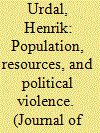

|
|
|
|
|
| Publication |
2008.
|
| Summary/Abstract |
Recent cross-national studies have found only moderate support for the idea that population pressure and resource scarcity may lead to political violence, contrary to much of the case study literature in the field. This article suggests that the level of analysis may be at the heart of this discrepancy. In a time-series study of political violence in 27 Indian states for the 1956-2002 period, it is tested whether high population pressure on renewable natural resources, youth bulges, and differential growth rates between religious groups are associated with higher levels of armed conflict, political violent events, and Hindu-Muslim riots. The results are generally more supportive of the resource scarcity and conflict scenario than recent global studies. The article further suggests that youth bulges affect all three forms of violence and that differential growth rates are positively related to armed conflict.
|
|
|
|
|
|
|
|
|
|
|
|
|
|
|
|
| 11 |
ID:
154699
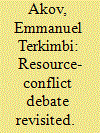

|
|
|
|
|
| Summary/Abstract |
The resource debate is easily discerned as part of the ongoing history of farmer–herdsman conflict in the North Central region of Nigeria. Scarcity theorists are adept at linking scarcity with the onset of livelihood conflict while on the other hand resource abundance pundits insist it is profusion and not scarcity that impels conflict. This article traverses these wrangles and proceeds to downplay the resource polemic altogether. It is proposed that the resource debate, despite its profoundness, presents a narrow reading of farmer–herdsman clashes in Nigeria’s North Central region. It is suggested that a number of other factors, including elite land grabbing, ethno-religious identity construction, weak state capabilities, the citizenship question, corrupt traditional institutions, the lack of an effective land tenure system and a widespread culture of impunity, make for better readings of the conflict. Owing to the negative impacts of the conflict on state and society, it is recommended that the state in Nigeria should commit itself to addressing the citizenship question, strengthening the capabilities of security institutions, extirpating the culture of impunity and revaluing its policy on land redistribution.
|
|
|
|
|
|
|
|
|
|
|
|
|
|
|
|
|
|
|
|
|